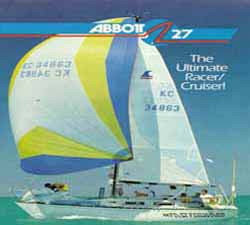Abbott 27
 By Steve Killing
By Steve Killing
When I review a new boat from an established builder or designer, I try to compare it with other boats they have produced. With Abbott, the boat I know best is the Abbott 33, a fast, sleek racing boat that you can still cruise on. I learned something interesting about the philosophy of the new Abbott 27 when I compared it with the 33. Although it is six feet shorter, their weights’ are the same.
Bill Abbott Sr., the designer (and builder), and his son Bill Jr., have kept their small shop purring along building international class Solings and Wayfarers. The Abbott 22, 33 and 36 are interspersed in smaller numbers but nevertheless make a significant contribution to their success. By the time Christmas rolls around they have built, in all, about a hundred boats each year.
The 27 is intended to be much more of a cruising boat than the 33. As well as being the same weight as the 33, it is actually beamier than its larger sister. All of this means there is more room to fit in the comforts of home and more load-carrying ability. Unfortunately, there is no drawing of the final interior layout. The first six boats sold will have custom interiors and the merits of each will be weighed. Boat number seven will be the first with a production interior. The Abbotts want to sell the 27 as a cruising boat, but Bill Abbott Jr. is quick to point out that this boat is by no means a slouch on the racecourse.
The proto-type, which was sailed in the mid-’80s with a flush deck, did exceptionally well in the MORC racing fleet. How nice to find a builder who actually uses a prototype hull as it should be used – as a one-off preliminary boat to try thins out, with changes made before tooling up for the production line. Often there is a great temptation to rush into production before the trials of the first boat are even complete, and then the benefits of the whole process are lost.
All other Abbott boats are solid laminates, but the 27 is the first to use balsa core in the hull. The philosophy in a sandwich laminate, which has layers of glass on either side of a core of end grain balsa, is to stiffen the hull without excess weight and cost. If you take the total thickness of fiberglass that you would normally use, put half on either side of core, then the resulting hull will be much stiffer. In small boats, taking half of that laminate often results in very thin skins, a bit too thin for straight puncture resistance, and therefore the external laminate must be thickened up again. The net result is a boat that is very stiff but may cost a little more to build. My guess is that this 27 is the small end of the range for getting the best use of cores in a hull. Abbott always produces a very fine product and the 27 is no exception.
Originally published in Canadian Yachting’s July 1987 issue.
Specifications
LOA 27 ft. 3 in.
Beam 9 ft.
Draft 5 ft.
Ballast 2,700 lbs.
Weight 6,000 lbs.
Sail Area 355 sq. ft.























